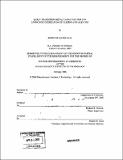| dc.contributor.advisor | Richard R. Schrock. | en_US |
| dc.contributor.author | Adamchuk, Jennifer | en_US |
| dc.contributor.other | Massachusetts Institute of Technology. Dept. of Chemistry. | en_US |
| dc.date.accessioned | 2006-11-07T12:33:00Z | |
| dc.date.available | 2006-11-07T12:33:00Z | |
| dc.date.copyright | 2006 | en_US |
| dc.date.issued | 2006 | en_US |
| dc.identifier.uri | http://hdl.handle.net/1721.1/34499 | |
| dc.description | Thesis (Ph. D.)--Massachusetts Institute of Technology, Dept. of Chemistry, 2006. | en_US |
| dc.description | Vita. | en_US |
| dc.description | Includes bibliographical references (leaves 176-183). | en_US |
| dc.description.abstract | Zirconium and Hafnium Ziegler-Natta catalysts containing the [(2,6- C12C6H3NCH2CH2)2NMe]2- ([ArciN2NMe]2') ligand were prepared and employed in the polymerization of 1-hexene. Hafnium Ziegler-Natta catalysts containing the [(2,6- X2C6H3NHCH2)2C(CH3)(2-C5H4N)] ([Arx2NPy]2-) (X = Cl or F) ligand were also prepared for use in 1-hexene polymerization studies. Compounds of the type [Ligand]MR2 (R = Me, i-Bu) were activated with {Ph3C}{B(C6F5)4}, B(C6F5)3, or {PhNMe2H}{B(C6F5)4} to yield monoalkyl cationic initiators paired with a weakly coordinating anion. Rates of consumption of 1-hexene were monitored, decomposition pathways studied, and living behavior assessed. Catalysts containing the ([ArcN2NMe]2-) ligand were more stable than those containing the analogous ([MesN2NMe]2-) ligand; however, living behavior was only observed for zirconium catalysts. Substitution of the mesityl amido substituents in [ArylNpy]2- hafnium complexes with aryl groups containing chlorines or fluorines (especially the latter) in the ortho positions was found to be detrimental to the development of living olefin polymerization catalysts of this general type. The catalytic activity steadily decreased in the order aryl = Mes > 2,6-Cl2C6H3 > 2,6-F2C6H3 and 1,2 and 2,1 -hydride elimination increased in the order aryl = Mes < 2,6-Cl2C6H3 < 2,6-F2C6H3. | en_US |
| dc.description.abstract | (cont.) Quinuclidine adducts of Mo(NAr)(CHCMe3)(O-t-Bu)2 and Mo(NAr)(CHFc)(O-t-Bu)2 (Ar = 2,6-diisopropylphenyl) were prepared and used as catalysts for the cyclopolymerization of diethyl dipropargylmalonate (DEDPM). Mo(NAr)(trans-CHCHCHMe)(O-t-Bu)2(quin) and Mo(NAr)(CH[5])(O-t-Bu)2, a species containing a five-membered ring alkylidene group analogous to the alkylidene that results from the cyclopolymerization of 1 equivalent of DEDPM by Mo(NAr)(CHCR)(O-t-Bu)2, were also synthesized for use in DEDPM polymerization studies. These catalysts cyclopolymerized DEDPM to produce polyenes with very low PDI values and Mn(found)/Mn(calculated) ratios 1.1. Ratios of the rate of propagation relative to initiation for these catalysts were less than 1, enabling the synthesis, isolation, and analysis of short oligomers. The initiation and polymerization processes were studied in detail using NMR spectroscopy. | en_US |
| dc.description.statementofresponsibility | by Jennifer Adamchuk. | en_US |
| dc.format.extent | 185 leaves | en_US |
| dc.format.extent | 9793322 bytes | |
| dc.format.extent | 9801120 bytes | |
| dc.format.mimetype | application/pdf | |
| dc.format.mimetype | application/pdf | |
| dc.language.iso | eng | en_US |
| dc.publisher | Massachusetts Institute of Technology | en_US |
| dc.rights | M.I.T. theses are protected by copyright. They may be viewed from this source for any purpose, but reproduction or distribution in any format is prohibited without written permission. See provided URL for inquiries about permission. | en_US |
| dc.rights.uri | http://dspace.mit.edu/handle/1721.1/7582 | |
| dc.subject | Chemistry. | en_US |
| dc.title | Early transition metal catalysts for the living polymerization of olefins and alkynes | en_US |
| dc.type | Thesis | en_US |
| dc.description.degree | Ph.D. | en_US |
| dc.contributor.department | Massachusetts Institute of Technology. Department of Chemistry | |
| dc.identifier.oclc | 70852151 | en_US |
